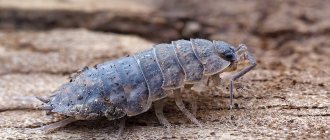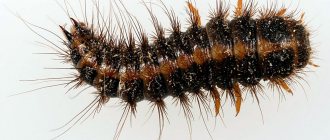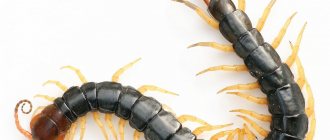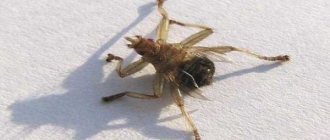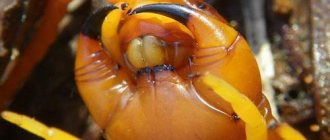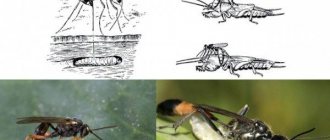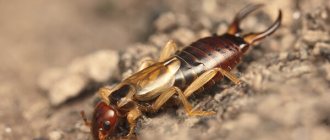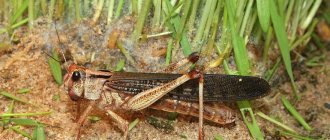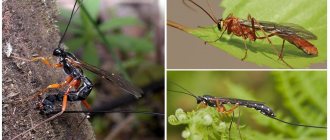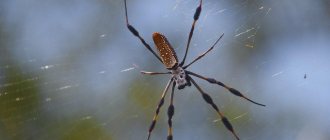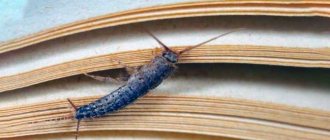As a rule, people more often mistake a moth for an inconspicuous small moth, after the appearance of which they conduct an inspection of all fur and other similar products in their apartment.
However, at the moment, there are many parasites in nature that cause some harm to a person, his home or garden plot.
In order to successfully fight female clothes moths or other types of similar parasites, you need to know everything about moths - how long they live, what they eat, etc. The main types of such parasites and other useful nuances are described below in this article.
Appearance
What does 1 common mole look like? This moth has a yellow color - gray or dark. A red tint is sometimes visible on the body of this insect.
Such a parasite has 2 pairs of shiny wings that shimmer in the sun. A fringe is visible along its edges. The span of the front wings of such a moth is 9–18.5 mm. The hind wings are more uniform in color and smaller in size.
The chest of such a small pest is brown on top and light yellow and shiny below.
The male of this insect is smaller than the female, and after mating with the female and fertilizing her, he quickly dies. The female of this small pest lives for about 1 month.
Main types
A moth is a very small butterfly whose wings are 7 mm maximum. If you put them together, you get a small triangle.
Currently there are the following types of moths:
- food;
- chestnut;
- cabbage;
- poplar;
- woolen;
- apple;
- rowan;
- potato;
- furniture.
Particular attention should be paid to what each of the above types of lepidopteran pests looks like.
There are not many of them, but such moths often cause significant damage to various things, food or humans.
food pest
The food moth is another small house insect. Its main types are such varieties of this moth as moth. This butterfly is active mainly at night.
What does such a food parasite look like? Its dimensions are 0.3-1 cm. This moth has a light gray or brown color.
This type of lepidopteran insect lives for 1–2 weeks. At this time, its larvae are formed, which spoil food or harm human health.
Such a moth reproduces only in those places that are comfortable for it, where there is a lot of moisture and water. In such a situation, its females lay eggs.
Thus, this type of house moth infects the following products:
- cereals;
- various types of nuts;
- cookie;
- chocolates;
- tea;
- spices;
- bakery;
- flour, bread;
- various sweets;
- beans;
- fruits or a variety of dried fruits.
When consuming products that are contaminated with such a small pest, a person causes the following harm to his body:
- a person experiences severe intoxication throughout the body;
- sometimes severe allergies appear;
- immunity decreases.
As a result, if such a lepidopteran moth has spoiled this or that product, it must be urgently thrown into the trash. Also, if this type of butterfly appears in the kitchen, then the person urgently needs to get rid of it.
Chestnut butterfly
Also at the moment there are such types of moths as, for example, the chestnut butterfly. This moth is an adult insect whose wingspan reaches 1 cm and their length is 7 mm.
The wings of this type of parasite have a red-brown color, on which white lines are clearly visible. This butterfly has a brown chest, gray abdomen and black and white legs. The eggs of this insect are 0.3 mm in length and have a light green color.
According to biologists, the invasion of chestnut-like pests occurs for 2 years in a row, and then they are not visible for several years. This butterfly lays eggs on the leaves of a variety of trees, and then caterpillars form from them. They feed on the sap of various plants.
On the leaves of various chestnut trees that are damaged by such a lepidopteran parasite, 1 or several brown spots appear, and the adult insect, upon emerging from the cocoon, destroys the leaf skin.
In the worst case, the chestnut tree loses its own foliage, as 100 or more larvae of this type of butterfly form on it.
Cabbage Moth
The cabbage moth is an inconspicuous small butterfly. The span of its small wings reaches 16 mm.
The wings of this moth are gray or dark brown. However, females have lighter wings than males. The edges of the hind wings have a light fringe.
The eggs of this insect are about 1 mm long. They also have an elongated shape and are covered in green.
This type of garden pest, not a home pest, feeds on various cruciferous vegetables.
In such a situation, he eats cabbage, rutabaga, radish, turnips, radishes, etc.
Poplar moth
The poplar moth or moth is a small parasite that damages poplar trees. This butterfly has black dots on its wings.
The narrow wings of this type of moth are covered with fringe, and their wingspan reaches 7 mm. This insect has a nondescript brown color.
Such a moth does not cause any harm to humans. The moth does not feed on various foods, does not destroy things or clothing, and does not spread specific ailments.
The presence of such a butterfly in the house causes more harm to the human nervous system, so the tenant gets rid of it as quickly as possible.
Sometimes such a lepidopteran pest flies into electrical appliances, equipment or lamps, causing them to malfunction and damaging their appearance.
In addition, pestra stains furniture and also sticks to curtains and tulle. Thus, this insect leaves behind stains that are difficult to remove.
wool butterfly
The wool moth is the most common type of this insect. Such a butterfly appears not only in various apartments and warehouses, but also in mills or museums.
The larvae of this parasite feed on contaminated clothing or dust.
The wings of such a moth correspond to the size of any similar insects - up to 2 mm. The front wings are covered with brown, which gives a pearlescent light tint.
The hind wings of this woolly pest are beige in color, and their edges are covered with fringe.
This type of parasite is very prolific. After all, his female lays up to 90 eggs during her short life.
Apple tree small pest
Apple moth is considered a dangerous small pest. This light butterfly lives in large and small apple orchards.
More often, the apple tree suffers from the adult larvae of this moth. After all, various garden moths feed on its leaves.
With a large number of apple parasites, the leaves curl inward, dry out, and then fall off. As a result, the apple tree remains without fruit for a long time.
Rowan Moth
What other moths are there? Rowan moths are also often found in garden plots. It is a small gray butterfly with a maximum wingspan of 1 cm. The length of this parasite is 6 mm.
The caterpillars of this pest are 1 cm long. They have a green-gray color, which sometimes has a red tint.
This insect feeds on the fruits of hawthorn or rowan. During mass reproduction or in lean years for rowan trees, this butterfly damages not only rowan trees, but also apple trees.
Potato butterfly
The potato moth or fluorimea is an inconspicuous insect. The eggs of such a butterfly are small in size (about 0.44 mm), so they are very difficult to notice.
The eggs of this insect are oval in shape and white in color, but as the embryo develops they darken. Egg clutches are located on the reverse leaf side and develop in only 2-3 days.
If fluorimea is infested on a plant, it completely destroys the entire bush - from the very top to the underground tubers.
Moreover, not only the potatoes themselves suffer, but also vegetables such as tomatoes, peppers, eggplants, etc.
As a result, when they attack crops, fluorimea moths harm people in the following way:
- weaken several potato or other bushes at once;
- reduce the quality of potatoes;
- sharply reduce the amount of seed potatoes;
- reduce productivity.
Furniture parasite
Furniture moths are considered another type of this small pest. The larvae of such a butterfly gnaw a small path to their food and their movement route is similar to tunnels.
In food that contains many natural ingredients, the larvae of this type of moth in an apartment grow at a very fast pace. As a result, after 25–30 days, they become sexually mature parasitic individuals, which then mate with females and quickly reproduce in closets with clothes.
Females of such lepidopteran insects are considered very fertile butterflies. After all, the number of eggs of this parasite in 1 oviposition sometimes reaches 200 pieces.
This type of lepidopteran moth is a serious small pest in a person’s home.
This butterfly feeds on clothes, carpets, various rugs or furniture upholstery.
In addition, this lepidopteran pest eats fur, wool, feathers or various products - animal bristles, which are used to make toothbrushes, as well as fiber for pianos, etc.
Reasons for appearance
To effectively combat moths, you need to find the source and reasons for its entry into the apartment .
The main reasons for the appearance of moths:
- Flew in through an open window on its own. If there is no protective net on it, then this insect can fly into the house and take root in it. Using a mosquito net will eliminate such troubles.
- Brought into the house along with things. These could be woolen or knitted clothes that you took from your grandmother. It is not necessary that these are adult pests: their larvae, which are difficult to notice, are sufficient. To prevent this from happening, things should be well ventilated and left in the sun for several hours before bringing them into the house.
- Came with old furniture. The larvae can be found in the upholstery of old sofas. They look like small white cocoons. Almost all old furniture is contaminated, so if there is a need to bring it into the house, you must first treat the fabric with special means.
- Introduced by domestic animals . Larvae may be on their fur, so you should periodically wash the animals with special shampoos that help get rid of any parasites.
- It came with cereals that were improperly stored in a warehouse, or with dried fruits and mushrooms purchased at the market.
Most often, moths enter an apartment along with new things that contain fur and wool.
How long does he live?
How long does a moth live? Its lifespan is considered an important indicator, because these types of butterflies actively eat clothing and furniture.
Before the onset of puberty, this parasite goes through 2 stages of development: egg and larva. At an ambient temperature of 20 degrees Celsius, 1 egg of such a moth takes 14 days to develop.
The development period of 1 larva is 3–9 months. At this time, the larvae of this parasite envelop themselves in a special cocoon, in which they develop in the future.
After the larva has formed into an adult and has wings, the new moth lives for a maximum of 30 days.
This period may be shorter depending on the type of butterfly.
If we sum up the above 3 time periods of development of this parasite, we get a very long period during which this pest does not destroy specific items from the wardrobe or furniture.
How many days does 1 such moth live? The duration of its life cycle is ultimately 30–60 days, of which the insect lives in the form of a butterfly for up to 14 days. The full development cycle from egg to the formation of an adult of such a parasite is 60 days - 2-3 years.
How long can a moth live without eating any grocery food or other food? Without food, its caterpillars can live a maximum of 30 days.
How long an adult moth lives depends on its species and gender. Females live 7–10 days, and the lifespan of a male is 30 days.
Prevention measures
There are a number of necessary requirements that will help keep your belongings and products safe and sound.
- When purchasing groceries, pay attention to the condition of cereals, flour, dried fruits, and herbs.
- Keep food in the house in closed jars or bags soaked in salt water.
- It is recommended to ventilate kitchen cabinets frequently, wipe the shelves with vinegar, and place lavender or orange peels on them.
- Observe the shelf life of products, especially nuts and dried fruits, as moths often infest them.
- Woolen and fur items should be kept clean, and any deterrents should be placed in the closet.
- When purchasing, carefully inspect for damage or moth larvae. It is important to regularly ventilate and inspect things.
- When preventing agricultural moths, premises are ventilated and treated before storing a new crop.
Reproduction and life stages
If a person knows how moths reproduce, then he carries out the necessary prevention and fights it more effectively.
How do house or other moths reproduce? First of all, you need to keep in mind that 5-6 hours after mating, the female immediately lays 50-100 eggs.
The optimal temperature for the development of 1 or several eggs is 30–33 degrees Celsius. At temperatures below 30 but above 15 degrees Celsius, the duration of egg maturation increases to 35 days.
Such a lepidopteran pest goes through the following 2 stages of development:
- larva. Under favorable conditions, larvae are born after a few days. These caterpillars are off-white in color. They develop in about 14 days and slowly increase in size to 1 cm;
- formation of a cocoon and an adult.
At the last stage of development, such a lepidopteran insect is covered with a cocoon. Such a pupa remains motionless for about 3 days.
Then a moth is born, ready to mate, and at this time its accelerated moth reproduction begins.
Is this parasite dangerous for humans?
Unlike other various parasitic insects, moths do not cause much harm to a person and his apartment if it is removed from the house in time. This moth often destroys only certain clothes.
Certain types of moths (for example, the cereal moth) damage food products such as cereals, chocolate and nuts. However, this type of moth does not cause significant harm to humans.
The only disadvantage of such a parasite is the contamination of food, as well as its rotten appearance.
Why are moths dangerous?
It harms a person in the following ways:
- spoils the appearance of food;
- contaminates dishes;
- destroys clothes;
- causes discomfort.
Such a lepidopteran parasite is dangerous to human health only if he does not get rid of it in a timely manner.
Video
Extremely dangerous! About potato moth
How to get rid of moth larvae?
While it is not difficult to get rid of butterflies, methods of fighting caterpillars are more labor-intensive.
Tips for killing food moth larvae in the kitchen:
- Thoroughly vacuum cabinets that have been emptied of food.
- Wash the interior surfaces and dry. Then wipe with a sponge soaked in apple cider vinegar.
- Inspect bags and containers with bulk products.
- If you find clutches or larvae, feel free to get rid of the food. They are toxic and not suitable for cooking.
- If there is no masonry, place the dishes with cereal in the microwave for 5 minutes. Turn on the microwave oven at maximum power. An alternative is to use the oven and freeze the food for a week.
- Wash containers with soap, dry, and wipe with vinegar.
To save clothes from clothes moth larvae, follow these steps:
- remove things from the closet, shake each one;
- get rid of the hopelessly damaged ones;
- take fur coats, coats, fur hats out onto the balcony under the sun’s rays;
- wash bed linen and woolen items for at least half an hour or freeze for 24 hours;
- wash the walls of the wardrobe with a special furniture cleaner, especially carefully - the far dark corners;
- place moth repellent on the shelves - tablets, balls, sections;
Sprays, aerosols, and taking things outside in sunny or frosty weather help destroy larvae on carpets, paths, and furniture.
Insect purpose
Why do you need cabbage or other moths? In addition to the disadvantages, it also has various advantages.
What are the benefits of moths? First of all, such an insect (in particular, the wax moth) is a raw material for the manufacture of effective medicines for tuberculosis, various cardiovascular ailments, lung diseases, or for stimulating the immune system.
In addition, various wax moth preparations increase a person’s immunity and physical activity, and also regulate energy metabolism.
